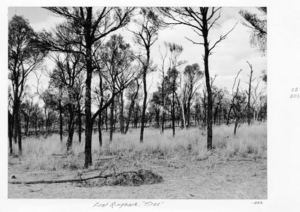Black gidyea facts for kids
Quick facts for kids Black gidyea |
|
|---|---|
 |
|
| Scientific classification | |
| Genus: |
Acacia
|
| Species: |
argyrodendron
|
 |
|
| Occurrence data from AVH | |
The Acacia argyrodendron, also known as black gidyea or blackwood, is a type of Acacia tree. It grows naturally in Australia. A Czech botanist named Karel Domin first described this tree in 1926. It still has the same scientific name he gave it. Domin found the first example of this tree in Queensland, Australia.
Contents
What Does Black Gidyea Look Like?
The black gidyea is a tree that can grow quite tall. It usually reaches between 8 and 25 meters (about 26 to 82 feet) high. Its bark is dark grey to black.
Its Special Leaves
Like many Acacia trees, the black gidyea doesn't have regular leaves. Instead, it has something called phyllodes. These are flattened leaf-like stems that do the job of leaves. The phyllodes of the black gidyea are long and narrow. They can be straight or slightly curved. They are about 8 to 17 centimeters (3 to 7 inches) long. They are also about 4 to 9 millimeters (0.16 to 0.35 inches) wide. These phyllodes have many thin lines, or nerves, running through them.
Flowers and Seeds
When the black gidyea blooms, it produces many small, golden flowers. These flowers grow in round clusters. Each cluster is about 3.5 millimeters wide. There can be 12 to 20 flowers in each cluster. These clusters appear in groups of 12 to 30 along a stem. This stem can be 2 to 6 centimeters long.
After the flowers bloom, thin, smooth seed pods form. These pods can grow up to 12 centimeters (about 5 inches) long. They are about 10 to 13 millimeters (0.4 to 0.5 inches) wide. Inside the pods are dull brown seeds. The seeds are soft and shaped like an oval. They are about 10 to 13 millimeters long.
How Scientists Classify Black Gidyea
Taxonomy is the science of naming and classifying living things. The black gidyea was first officially described by the botanist Karel Domin in 1926. This description was part of a larger scientific work. For a short time in 1987, it was given a different scientific name, Racosperma argyrodendron. However, in 2001, it was moved back to the Acacia group.
Where Does Black Gidyea Grow?
The black gidyea tree is found in central Queensland, Australia. It grows in areas where the annual rainfall is between 475 and 655 millimeters (about 19 to 26 inches). You can often find it in clay soils near rivers. These rivers include the Cape, Suttor, and Belyando Rivers.
Its Forest Home
This tree often forms open forests. It can be the main tree species in these areas. Sometimes, it's the only tree species you'll see. Other plants grow beneath the black gidyea trees. These are called understory plants. They include shrubs like false sandalwood (Eremophila mitchellii). Yellow-wood (Terminalia oblongata) and conkerberry (Carissa spinarum) also grow there. Smaller plants like brigalow grass (Paspalidium caespitosum) and yakka grass (Sporobolus caroli) are also common.
Sometimes, other trees might grow alongside the black gidyea. These can include Dawson River blackbutt (Eucalyptus cambageana). Coolibah (Eucalyptus coolabah) and Brown's box (E. brownii) are also seen.
Similar Trees in Different Places
Another tree called gidgee (Acacia cambagei) grows in drier areas. It takes the place of black gidyea there. In wetter areas, you might find brigalow (Acacia harpophylla). Brigalow also grows in some of the same southern and eastern areas as black gidyea.
Plants That Live On It
The black gidyea can be a host plant for certain types of mistletoe. Mistletoe is a plant that grows on other plants. Some mistletoe species found on black gidyea include Amyema preissii and Amyema quandang. The harlequin mistletoe (Lysiana exocarpi) also grows on it.

